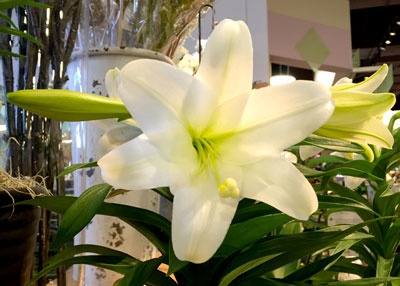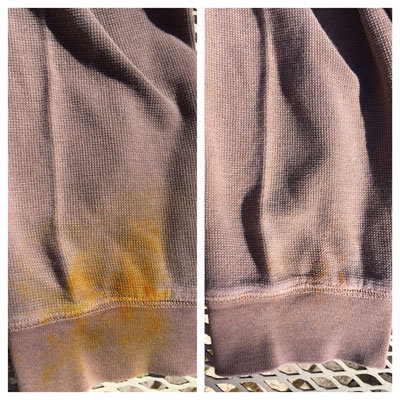Happy Easter!
I went to school to become a great greenhouse grower. (Somewhere that plan ran slightly off course.) Poinsettias were going to be a starting point. And pot mums and even azaleas. But everybody warned me not to grow Easter lilies. I’ll explain why in a moment, but first I’m going to help you enjoy the ones you have to the fullest.

Photo: It’s hard to pass a rack of lilies at the flower shop and not bring one or two home to enjoy.
Extending the bloom time of your lily…
You may have gotten your plant sleeved in a brown paper wrap to protect it. We’ll start from there.
1. If it is sleeved, remove the sleeve from the bottom up, carefully tearing it away. Our instinct is to try to save the sleeve. Trust me – you have absolutely no reason to do so.
2. Keep your plant moist, bright and cool – just as it was in the greenhouse. Do not leave it standing in water, however.
3. As the individual flowers just start to open, carefully pinch off the anthers (flower parts that contain pollen) with tweezers. The pollen will stain the petals, and it’s sticky.
4. Avoid hot drafts and bright, warm windows. They will cause flowers to fade prematurely.
What to do when it’s through blooming…
When the plant has finished flowering, plant it into your perennial garden. It will do best in morning sun with afternoon shade. It will bloom again next year – probably a few weeks after Easter, but don’t be surprised if it plays out after a few years, due primarily to the Texas summertime heat.

Photo: Sweatshirt once stained with lily pollen is almost clean following hours in the sun.
Handy Tip:
A few months ago I brushed against pollen in some lilies at a local McKinney flower shop. Stacy Edwards, the owner, advised me to lay my sweatshirt out in the sun for a few hours. I didn’t try to daub off the pollen – that would have been my natural reaction, but she urged me not to do that. I just let the sunlight perform its magic. Pretty amazing what a difference that treatment made. What you see is solely the work of the sunshine. No cleaner, no water, no solvent.
Why Easter lilies have the bad reputation with growers…
So I need to finish up on the old business of why many growers shy away from this lovely flower. Once you hear the reasons, you’ll understand fully.
• Other crops, like poinsettias for Christmas, are grown for a specific harvesting date. But Easter can vary by almost one month from late March past the middle of April.
• Cuttings for mums or poinsettias are more or less uniform, grown in ideal conditions and very predictable. Easter lily bulbs, by comparison, are grown in fields in the Pacific Northwest (and elsewhere), subject to the whims of the weather.
• The greenhouse grower pots the bulbs up pretty much as soon as poinsettias are sold. That date is fairly predictable, but remember that they will be expected to be salable just before Easter, so their maturity date can vary by as much as 25 days.
• Winter and early spring growing conditions can vary greatly depending on sunlight and temperatures.
• The grower can speed the crop by warming the greenhouse or slow it down by keeping things cool. But every adjustment of that sort runs the risk of knocking off flower buds. That’s the way the plants react to extreme changes.
• Easter lilies also tend to get lanky if they’re grown in excessively warm conditions.
• Bud count, and to a lesser degree, plant height determine the price the grower gets for the finished Easter lilies, so every adjustment that’s made runs the risk of costing big dollars.
